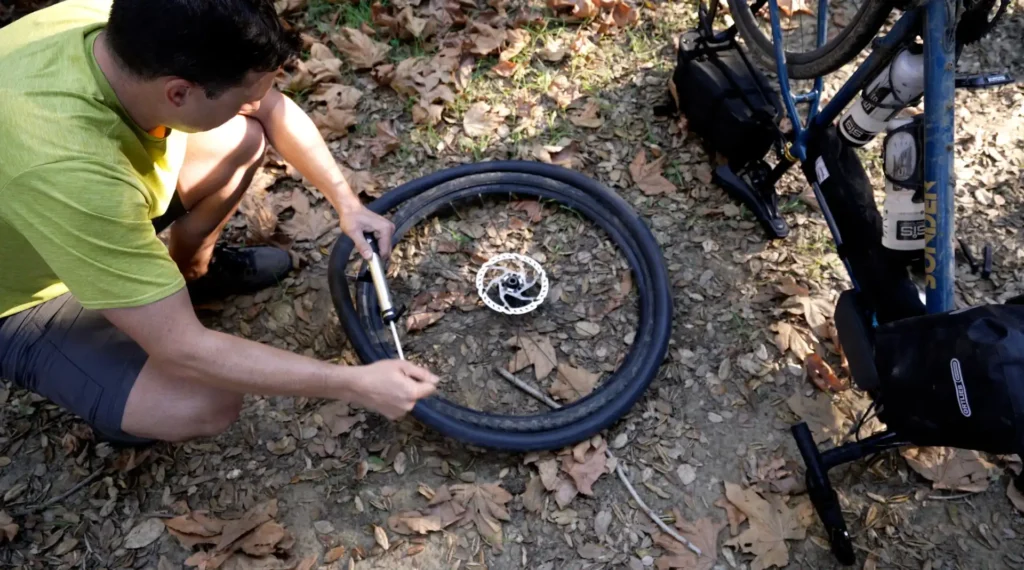Whether you’re a seasoned cyclist or a casual rider, knowing how to fix common bike problems is a useful skill that can save you time and money. Most bike issues can be resolved quickly with the right tools and a little know-how. In this blog, we’ll walk you through how to fix some of the most common bike problems, so you can keep your bike in top condition and avoid disruptions to your rides.
Let’s dive in!
1. How to Fix a Flat Tire
A flat tire is one of the most common bike issues you’ll face, but it’s also one of the easiest to fix yourself. With the right tools and a bit of practice, you’ll be able to get back on the road in no time.
What you’ll need:
- Tire levers
- A new inner tube (or a patch kit)
- A pump
- Wrench (optional, depending on your bike)
Steps:
- Remove the wheel: If the tire is on the front wheel, just release the brakes and remove the wheel. If it’s on the rear, shift your bike to the smallest gear and use the quick release or a wrench to remove the wheel.
- Remove the tire: Use tire levers to pry the tire off the rim. Start on one side, working your way around until the tire is fully removed.
- Replace or patch the tube: If you’re replacing the inner tube, remove the old tube and place the new one inside the tire. If you’re patching the tube, locate the hole, apply the patch according to the instructions, and ensure the patch seals completely.
- Reinstall the tire: Place the tire back onto the rim, making sure it’s seated correctly. Use your tire levers if necessary.
- Inflate the tire: Pump the tire to the recommended pressure, which is usually printed on the side of the tire. Once inflated, reinstall the wheel on the bike and make sure everything is secure.
With a little practice, fixing a flat tire can become a quick and easy part of your routine!
2. How to Fix a Slipped or Broken Chain
A slipping or broken chain can quickly derail your ride, but it’s a fixable problem with a few simple tools. Whether the chain is skipping, slipping, or completely broken, here’s how you can handle it yourself.
What you’ll need:
- Chain tool or quick link tool
- Replacement chain links (if needed)
- Lubricant
Steps:
- Check the chain: If the chain is simply slipping, it might need lubrication or adjusting. Clean the chain with a rag and apply a bike-specific lubricant to ensure smooth operation.
- Fix a slipped chain: If the chain has come off the gears, shift the bike to the smallest gear, gently pull the chain back onto the sprockets, and rotate the pedals to ensure it’s properly seated.
- Replace a broken chain: If the chain is broken, use a chain tool to remove the damaged section. Measure the new chain to the proper length, and use the chain tool to install a new link. If your bike uses a quick link, install it by following the manufacturer’s instructions.
To prevent future chain issues, keep it clean and properly lubricated, and check for wear regularly.
3. How to Adjust Your Brakes
Brakes are one of the most important safety components on your bike, so it’s crucial that they’re in top working condition. Over time, brake pads can wear down or brake cables may stretch, affecting performance. Fortunately, adjusting your brakes is something you can do yourself.
What you’ll need:
- Allen wrenches (usually 5mm or 6mm)
- Brake cable adjusters (if needed)
- New brake pads (if worn out)
Steps:
- Check brake pad alignment: Make sure the brake pads are aligned properly with the rim. If they’re misaligned, use an Allen wrench to loosen the bolts and reposition the pads.
- Tighten the brake cables: If your brakes are loose or unresponsive, you may need to tighten the brake cables. Locate the cable adjusters near the brake levers or at the brake calipers. Turn them clockwise to tighten and improve brake response.
- Test the brakes: After adjusting, squeeze the brake levers and check that the pads contact the rim evenly. Test the brakes at low speed before heading out on a ride to ensure they are functioning properly.
- Replace the brake pads: If your brake pads are worn down, replace them. Simply remove the bolts holding the old pads in place and install the new pads. Make sure they are aligned correctly before tightening everything back up.
Regular brake checks and adjustments will keep your bike stopping safely.
4. How to Fix Loose or Wobbly Handlebars
A loose or wobbly handlebar can make riding uncomfortable and dangerous. This is a simple fix that requires only a few tools.
What you’ll need:
- Allen wrenches (typically 4mm, 5mm, or 6mm)
- Torque wrench (optional)
Steps:
- Tighten the stem bolts: First, check if the bolts holding the handlebar stem in place are loose. Use an Allen wrench to tighten the bolts evenly, starting from the top and working your way down. Avoid over-tightening, as this could damage the stem or handlebars.
- Check the headset: If the handlebars still feel wobbly, the headset (the mechanism that allows the handlebars to turn smoothly) may be loose. Use your Allen wrench to tighten the headset bolts, which are typically located near the top of the fork.
- Test for stability: Once everything is tightened, test the handlebars by gently rocking the bike back and forth. If the handlebars feel secure, you’re good to go.
Having your handlebars firmly in place ensures better control and comfort during your ride.
5. How to Fix a Misaligned Wheel
A misaligned wheel can affect your bike’s handling and cause unnecessary wear on the tires. This can happen due to an accident, hitting a pothole, or simply from wear over time. Fixing a misaligned wheel is a relatively straightforward task.
What you’ll need:
- A wrench or quick-release lever
- A spoke wrench (if necessary)
Steps:
- Check the wheel for damage: Spin the wheel and check if it wobbles or rubs against the brake pads. If it does, the wheel may need to be trued (aligned).
- Tighten the spokes: If you have a spoke wrench, check for any loose spokes and tighten them. A spoke that is too loose can cause the wheel to be out of true. Tighten or loosen spokes to even out the tension.
- Use a truing stand (optional): If you have a truing stand, you can use it to fine-tune the wheel’s alignment. If not, simply spin the wheel and adjust spokes gradually until the wheel no longer rubs against the brakes.
If you’re unsure about truing the wheel yourself, you can visit a local bike shop for professional help.
Conclusion
Fixing common bike problems doesn’t have to be difficult or expensive. With a few basic tools and some practice, you can handle most bike repairs yourself. Whether it’s fixing a flat tire, adjusting your brakes, or tightening loose handlebars, these simple fixes can keep your bike in top condition and ensure that your rides are smooth and enjoyable.
Don’t let bike problems slow you down—learn these easy fixes and keep your bike rolling smoothly. Happy riding!

